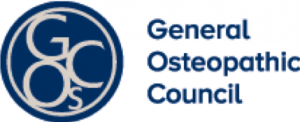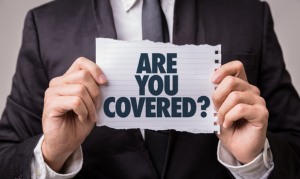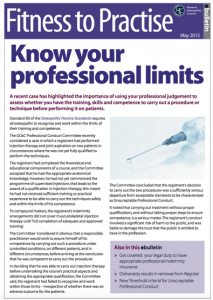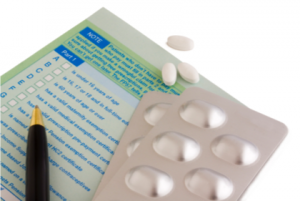
Can Osteopaths carry out diagnostic ultrasound and can they inject? Over the past 5 years we have had more and more Osteopaths on our course and this year particularly a significant number of enquiries from Osteopaths asking if they can use diagnostic ultrasound in clinic to diagnose pathology and guide injections. Osteopaths are autonomous practitioners who diagnose and treat a variety of musculoskeletal conditions. I recently taught at the British School of Osteopathy (BSO), now called the University College of Osteopathy (UCO) and we had some very interesting discussions within the group around competency. As always competency based questions around ultrasound are never a simple answer.

To try and provide some guidance for Osteopaths on these questions I put myself in the shoes of someone starting out in diagnostic ultrasound and went through the process of ‘finding out’ some of answers to these questions. As a registered osteopath myself the first place to start should be your regulating body, the General Osteopathic Council (GoSC) This phone call did not take long!
Question 1: Is diagnostic ultrasound within the scope of practice for Osteopaths
I spoke to someone in the GoSC in the professional advisory team. My question was simple, as an Osteopath can I carry out diagnostic ultrasound in clinic to diagnose joint, tendon, muscle and ligament problems. The answer was not vague, not grey it was a simple answer, ‘No’. The lady went on to say ‘diagnostic ultrasound is not within the scope of an Osteopath, is there anything else I can help you with? I said I knew of lots of Osteopaths who use diagnostic ultrasound in their clinic. She said ‘ sorry I cannot comment as it is outside the scope of Osteopathy’. The phone call seemed very unhelpful so I called up the next week but received a similar answer.

So to answer the question I reviewed the Osteopathic Standards of Practice. ‘Standard B3 of the Osteopathic Practice Standards requires all osteopaths to recognise and work within the limits of their training and competence’. This sentence is very similar to that of the Chartered Society of Physiotherapists (CSP) Practice Standards. Essentially it allows the individual practitioner to work within his or her own defined scope of practice. An Osteopath can use diagnostic ultrasound in their clinic to help diagnose MSK complaints, but they must be able to prove their competency. It would not be appropriate for Osteopaths to start using diagnostic ultrasound for scanning non – MSK structures for example pregnancy scanning or internal organs.
Just attending a course does not prove competency. Like any element of a clinicians practice it is the clinicians responsibility to be able to provide documentation of their training and learning pathway. MSK Ultrasound is a very operator dependent imaging modality with a steep learning curve which takes hundred of hours to achieve a basic level of competency. Certain elements must be fulfilled to prove competency in MSK Ultrasound. These are:
1/ Attend the appropriate courses
2/ Spend time observing and scanning with a variety of clinicians from different clinical backgrounds
3/ Direct experience and supervision with an adequately trained clinical tutor/supervisor
3/ Keep a logbook of scans
4/ Audit your scans and reflect on the results/discrepancies
5/ Pass a competency-based exam
This should be a continual cycle of learning, reflecting and developing your practice.
Just attending a course does not prove competency. I would advise at this point you read my article Training in MSK Ultrasound: How do you become competent? This article is relevant to all professions that want to learn MSK Ultrasound.
Question 2: I am insured?
The next questions people always ask is ‘I am insured as an Osteopath to carry out diagnostic ultrasound?’ Many Osteopaths get their insurance through ‘Balens’ (including myself) (www.balens.co.uk). I am sure the process would be similar with other insurance companies. Balens were certainly helpful and the process was very simple. I called them up and said I had attended a one-day course in diagnostic ultrasound (similar to the one I do at BSO/UCO) and they asked for the certificate for which I sent them one. About a week later I received an email saying ‘thank you for the information you provided, we have updated your policy to include diagnostic ultrasound’. There was no extra fee and no more questions asked. So I had ticked the box of insurance, surprisingly easily…. but had I?
On one hand this is great, I am now ‘insured’ to scan, but for some clinicians it may give the feeling that carrying out diagnostic ultrasound in clinic does not come without its own clinical risks. In fact you are making yourself more vulnerable to medico-legal issues by introducing diagnostic ultrasound into your clinical practice particularly around mis-diagnosis. Just because you are insured does not mean you are competent. If you are not competent your not insured. If a case is brought against you then you MUST be able to prove your competency otherwise your insurance is not valid.
Unfortunately competency in MSK Ultrasound is a contentious subject. I would advise at this point you read my article Training in MSK Ultrasound: How do you become competent if you haven’t already! Whether you are a physiotherapist, osteopath, sports doctor or radiologist you have to prove that you have attended the correct courses, logged the correct number of scans, and audited your scans against other imaging, surgical findings or an experienced clinician using ultrasound. As with any osteopathic skills, such as cervical manipulation, you must become competent and then maintain your competency through continual professional development by attending courses and meetings to refine, discuss and reflect on your these skills.
If you are looking to learn diagnostic ultrasound try and seek out other clinicians either in your clinic or in your local area to work alongside. It is far easier if you have someone you can discuss cases with and practice with (scan each other). It is essential to scan ‘normal’; subjects to at the beginning and not to concentrate on patients with pathology. You need to know what spectrum of ‘normal’ anatomy looks like to be able to recognise pathology or ‘abnormal’ anatomy. This may be another Osteopath but can equally be a physiotherapist, sports doctor, sonographer or radiologist. It is important you seek out learning opportunities to observe other clinicians using diagnostic in a variety of environments e.g. a physiotherapist using it in a private clinic or a radiologist or MSK Sonographer carrying their ‘MSK list’. This will give you a broad learning experience and help you to develop your skills and clinical application of ultrasound.
Question 3: Can osteopaths inject?
An osteopath who has the adequate training is able to carry out ultrasound guide injections. The key areas we must be consider are how do osteopaths get competent to carry out ultrasound-guided injections, what is the situation regards insurance and how do they obtain their drugs.
Competency:
There is a currently no agreed competency pathway for any clinicians to carry out ultrasound guided injections. To gain competency we would suggest you attend an accredited post-graduate university based injection course first. These courses teach ‘unguided’ injection techniques. They provide the theory and practice required to carry out musculoskeletal injections safely and effectively. These courses require you to carry out and log 10 assessed injections. This will require the delegate to obtain a clinical supervisor/assessor. Ten injections is obviously not enough to be competent at all injections so we suggest you continue with regular mentoring and supervision after you have completed the course, as with any clinical skill.
These courses are currently available at a number of universities including:

Once you have completed an unguided injection course and have a basic skill level in MSK Ultrasound you can then attend our 2-day cadaveric-guided injection course. If you are relatively new to scanning we would advise you attend our Introduction to MSK Imaging and have a basic level of ultrasound probe skills before attending our cadaveric-guided injection course to ensure you gain the most out of the course. The course takes place at the world-class facilities of St Georges Medical School in London
The course provides the perfect learning environment to practice, practice and practice some more! Like any skill practice makes perfect and guided injections are no exception. Delegates are taught all upper and lower limb articular and peri-articular injections over the 2 days and get the opportunity to practice these injections as many times as they like. The course gives you ample practice time on our full -bodied soft embalmed cadavers (the closest you can get to the real thing!) with close supervision from our expert tutors. We have developed the easiest and most effective techniques for all joint and soft tissue injections. Following the course you will be able to start carrying out ultrasound guided injections in your clinic. However, like the ‘unguided’ injection courses, we advise you carry out and log 10 ‘guided’ injections under supervision.
Essex University are the only university-based course that provides a ‘guided’ injection module. One of our SMUG course tutors, Mark Maybury, an Extended Scope Physiotherapist (ESP) is one of the course leads.
For more information https://www1.essex.ac.uk/hhs/documents/cpd/hs974-ultrasound-guided-musculoskeletal-injections.pdf
Insurance:
Any clinician carrying out ultrasound-guided injections must have the correct insurance. All practicing osteopaths are required by law to have professional indemnity arrangements in place that provide appropriate cover for potential claims. Failure to do so is a serious matter, even if no claims are made against an osteopath.
practitioner level Injections
Injections;
It is the responsibility of the practitioner to contact their insurance company, ensure that injections are added to their insurance policy and they must receive individual written confirmation. This may increase cost of their premium.

If the clinicians are employed then the employer of the individual must also ensure they have adequate employers (‘vicarious’) liability to cover a practitioner carrying out injections.
A recent case has highlighted the importance of using your professional judgment to assess whether you have the training, skills and competence to carry out a procedure or technique before performing it on patients. The registrant carried out an injection on clients before they completed all elements of their injection course. Their indemnity arrangements did not cover musculoskeletal injection therapy until ’full completion of adequate and approved training’. To read the full article see: www.osteopathy.org.uk/news-and-resources/...to.../ftp-bulletin-may-2015.pdf

How you obtain the drug:
At present Osteopaths cannot be independent prescribers unlike physiotherapists or podiatrists. If an Osteopath wants to inject steroid, local anaesthetic or any other prescribed drug they can only obtain the drug through a clinician who has assessed a patient and prescribed them a specific drug at a specific dose for the specific patient. This is known as a Patient Specific Directive (PSD). A PSD is the traditional written instruction signed by a doctor, dentist or non-medical prescriber for medicines to be administered to a named patient.

Osteopaths can inject non-prescription injectables such as hyaluronic acid used for osteoarthritis, without the need for a prescription. Hyaluronic acid if classified as a ‘medical device’ not a drug.
In conclusion, there are many factors to consider when discussing training pathways and gaining competency in MSK Ultrasound and carrying out guided injections. On a personal note adding these skills to my scope of practice has transformed the way I work and provides a unique one-stop shop to my clients. It has revitalised my enthusiasm to my job and provided many career opportunities that otherwise would not have presented themselves.
I hope you have found this article useful and I hope to see you on one of our courses soon! If you have any questions please do not hesitate to contact Chris Myers (Chartered Physiotherapist & Registered Osteopath) at info@ultrasoundtraining.co.uk